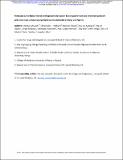| dc.contributor.author | Thomas Edwards, Christopher T Williams, Macrine Olwala, Pauline Andang'o, Walter Otenio, Grace N Nalwa, Abimbola Akindolire, Ana I Cubas Atienzar, Toby Ross, Kemi Tongo, Emily R Adams, Helen Nabwera, Stephen Allen | |
| dc.date.accessioned | 2022-01-22T07:27:31Z | |
| dc.date.available | 2022-01-22T07:27:31Z | |
| dc.date.issued | 2022-01-01 | |
| dc.identifier.uri | https://repository.maseno.ac.ke/handle/123456789/4487 | |
| dc.description | https://www.medrxiv.org/content/10.1101/2022.01.06.22268735v1 | en_US |
| dc.description.abstract | Objectives
Neonatal sepsis, a major cause of death amongst infants in sub-Saharan Africa, is often gut derived.
Impairments in immunity and the gut barrier in sick neonates allow colonisation by opportunistic
pathogens such as Enterobacteriaceae to progress to blood stream infection. Colonisation by
Enterobacteriaceae producing extended spectrum beta-lactamase (ESBL) or carbapenemase enzymes is
particularly problematic and can lead to antimicrobial-resistant (AMR) or untreatable infections. We
sought to explore the rates of colonisation by ESBL or carbapenemase producers and their genotypes in
two neonatal units (NNUs) in West and East Africa.
Methods
Stool and rectal swab samples were taken at multiple timepoints from newborns admitted to the NNUs
at the University College Hospital, Ibadan, Nigeria and the Jaramogi Oginga Odinga Teaching and
Referral Hospital, Kisumu, western Kenya. Samples were tested for ESBL and carbapenemase genes
using a previously validated qPCR assay with high resolution melt analysis. Kaplan-Meier survival
analysis was used to examine colonisation rates at both sites.
Results
A total of 119 stool and rectal swab samples were taken from 42 infants admitted to the two NNUs. Six
(14.3%) infants were extremely preterm (gestation <28 weeks), 19 (45.2%) were born by Caesarean
section and 3 (8.6%) mothers were HIV positive. Median (IQR) duration of admission was 12.5 (5-26)
days and 12 (28.6%) infants died. Overall, colonisation with ESBL (37 infants, 89%) was more common
than with carbapenemase producers (26, 62.4%; P = 0.093). Median survival time before colonisation
with ESBL organisms was 7 days and with carbapenemase producers 16 days (P=0.035). The majority of
ESBL genes detected belonged to the CTX-M-1 (36/38; 95%), and CTX-M-9 (2/36; 5%) groups. The most
prevalent carbapenemase was blaNDM (27/29, 93%). Single blaVIM (1/32, 3%) and blaOXA-48 genes (1/32,
3%) were also detected.
Conclusions
Gut colonisation of neonates by AMR organisms was common and occurred rapidly in NNUs in Kenya
and Nigeria. Active surveillance of colonisation will improve the understanding of AMR in these settings
and guide infection control and antibiotic prescribing practice to improve clinical outcomes | en_US |
| dc.publisher | Cold Spring Harbor Laboratory Press | en_US |
| dc.title | Molecular surveillance reveals widespread colonisation by carbapenemase and extended spectrum beta-lactamase producing organisms in neonatal units in Kenya and Nigeria | en_US |
| dc.type | Article | en_US |

